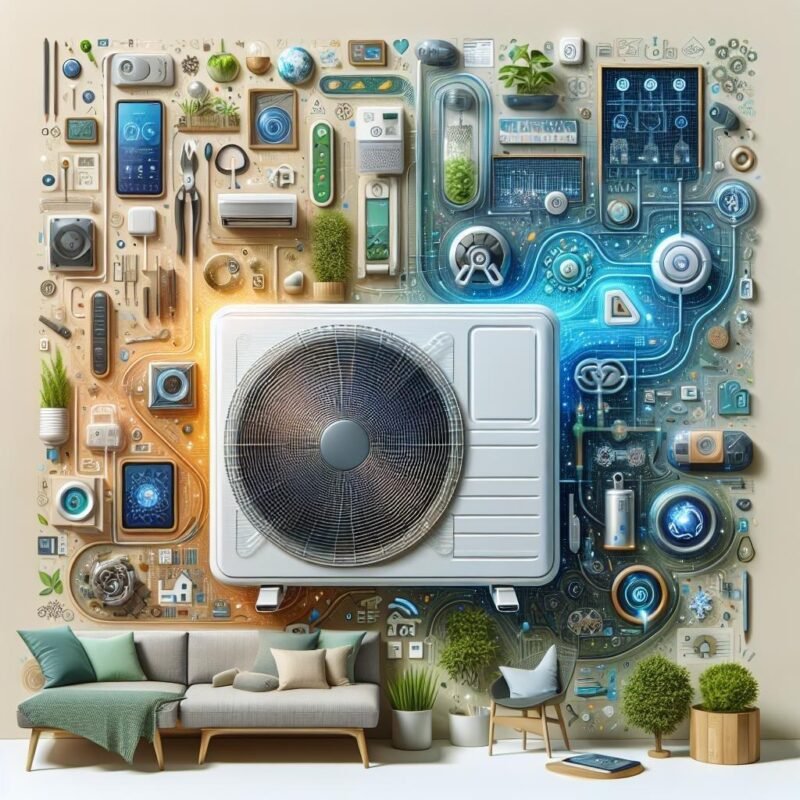Are mini split AC systems energy efficient?

Picture this: a scorching summer day, and you’re desperately seeking the perfect balance between comfort and your electricity bill. Enter the mini split AC system, the sleek, modern cooling solution that’s been turning heads in the HVAC world. As homeowners increasingly search for ways to beat the heat without breaking the bank, these refined units have sparked quite the buzz. but here’s the million-dollar question that’s probably on your mind: Are these stylish wall-mounted wonders really the energy-saving champions they’re claimed to be? Let’s dive into the cool facts and find out if mini splits truly deserve their reputation as the eco-friendly cooling solution of the future.
Understanding Mini Split Energy Efficiency Ratings and What They Mean for Your Home
When it comes to cooling your home, those mysterious numbers like SEER and HSPF can feel like trying to decode a secret language. let’s break it down: SEER (Seasonal Energy Efficiency Ratio) measures how efficiently your system cools during summer, while HSPF (Heating Seasonal Performance Factor) tells you about heating performance in winter. Most mini splits boast SEER ratings between 16 and 30 – compare that to customary AC units that typically max out at SEER 21, and you’ll start to see why these innovative systems are gaining popularity among energy-conscious homeowners.
But what do these ratings mean for your wallet? A mini split with a SEER rating of 20 could save you up to 50% on cooling costs compared to older systems with SEER 10. Think of it like mpg in cars – the higher the rating, the less energy you’ll consume to maintain your ideal temperature. Here’s a swift look at potential savings:
| SEER Rating | Annual Energy Savings |
|---|---|
| 16 SEER | 30% |
| 20 SEER | 50% |
| 25+ SEER | 60%+ |
- Higher SEER ratings mean superior energy efficiency
- Modern mini splits often exceed traditional AC efficiency
- Look for ENERGY STAR certified units for best performance
- Consider both SEER and HSPF for year-round savings
The Hidden Cost Benefits of Mini Split Systems Compared to Traditional AC units
Beyond the initial investment, one of the most compelling advantages of ductless systems lies in their ability to slash long-term expenses. By eliminating the need for ductwork maintenance and preventing the common 30% energy loss through leaky ducts, these innovative cooling solutions put more money back in your pocket. Smart zoning capabilities allow you to cool only occupied spaces, while advanced inverter technology adjusts power consumption based on real-time cooling demands.
Let’s break down the financial perks that often go unnoticed:
- Lower monthly utility bills due to precise room-by-room temperature control
- Reduced maintenance costs with no duct cleaning or sealing required
- Extended system lifespan thanks to efficient operation cycles
- Potential tax credits and utility company rebates for energy-efficient upgrades
- Increased property value with modern climate control technology
| cost Factor | Mini Split | Traditional AC |
|---|---|---|
| Annual Energy Loss | 3-5% | 25-40% |
| Maintenance Frequency | 1-2x yearly | 3-4x yearly |
Smart Zoning and Temperature Control Features That Slash Your energy Bills
Ever wondered how to achieve perfect room-by-room comfort while keeping your utility bills in check? these innovative systems allow you to create distinct temperature zones throughout your home, letting you cool only the spaces you’re using. With advanced sensors and programmable settings, you can automatically adjust temperatures based on occupancy patterns, time of day, or even connect to your smart home system for optimal efficiency.
Take control of your comfort with customizable scheduling features that adapt to your lifestyle. Set different temperatures for your home office during work hours, adjust the bedroom for perfect sleeping conditions, or maintain a cozy temperature in your living space for evening relaxation. The built-in follow-me technology uses remote sensors to detect your location and adjusts cooling patterns accordingly, ensuring you’re always comfortable while minimizing energy waste in unused areas.
| Zone | Recommended Settings | Energy Savings |
|---|---|---|
| Bedrooms | 72°F (night) / 78°F (day) | 15-20% |
| Living Areas | 75°F (occupied) / 80°F (empty) | 20-25% |
| Home Office | 74°F (work hours) / 78°F (off hours) | 18-22% |
Maximizing Mini Split Performance Through Proper Installation and Seasonal Maintenance
To unlock the full potential of your ductless system, precise placement and professional installation are absolutely crucial. The indoor air handler should be mounted at least 7 feet high on an interior wall,away from direct sunlight and heat sources. Proper refrigerant line length and insulation are essential – longer lines can reduce efficiency, while inadequate insulation leads to energy waste. The outdoor condenser unit needs adequate clearance and a sturdy, level mounting surface to operate optimally. Expert installers will also ensure correct wire sizing and circuit protection to prevent electrical issues that could impact performance.
Regular maintenance keeps your mini split running at peak efficiency throughout changing seasons.Simple homeowner tasks make a big difference:
- Monthly filter cleaning to maintain airflow
- Keeping outdoor unit clear of debris and vegetation
- Checking drain lines for clogs during humid months
- Inspecting insulation for damage or deterioration
| Maintenance Task | Frequency |
|---|---|
| Professional Tune-up | Annually |
| Coil Cleaning | Semi-annually |
| Filter Service | Monthly |
Q&A
Q&A: Are Mini Split AC Systems Energy Efficient?
Q1: What exactly is a mini split AC system?
A1: Great question! A mini split AC system is a type of heating and cooling system that consists of two main components: an indoor unit (or multiple units) and an outdoor condenser. They’re super versatile and can be a fantastic option for homes of all shapes and sizes,especially those without ductwork!
Q2: how do mini split systems work?
A2: Think of them as the superheroes of home climate control! They work by transferring heat from inside your home to the outside air in the warmer months and doing the reverse in the colder seasons. The indoor unit delivers that crisp, cool air right where you need it—without all the ductwork hassles!
Q3: Are mini split AC systems energy efficient?
A3: Absolutely, they generally are! Mini splits are known for their high efficiency ratings. Many models boast SEER (Seasonal Energy Efficiency Ratio) ratings above 20, wich means they can cool your home while drinking less energy than traditional systems. Plus, as they provide zoned cooling, you’re only cooling the rooms you actually occupy—how efficient is that?
Q4: Do they really save on energy bills?
A4: Yes, they can! Say goodbye to those frustratingly high energy bills. Because mini splits use inverter technology, they adjust their cooling or heating output based on the temperature needs of your space, avoiding those energy-hogging on/off cycles common in traditional systems.You could see some nice savings over time!
Q5: What about installation costs?
A5: Ah, the big question! While the upfront cost of purchasing and installing a mini split system can sometimes be higher than conventional AC units, remember: it’s an investment! You might recoup those costs through energy savings, plus enjoy more efficient cooling and improved comfort.
Q6: Are there any downsides?
A6: Like any superhero, mini splits come with a couple of kryptonite-like drawbacks. Some folks find the indoor units a bit noisy—I mean, they do hum to life occasionally! And if you need multiple zones, those units can add up in cost. but trust me, when you enjoy a perfectly cooled space during a muggy summer, you might just forget all about it!
Q7: How can I maintain my mini split for maximum efficiency?
A7: It’s simple! Regularly clean or replace filters, keep the outdoor unit free from debris, and schedule an annual maintenance checkup. Think of it as giving your mini split a spa day. A little love goes a long way in keeping it as energy-efficient as possible!
Q8: Are mini split systems good for the habitat?
A8: Absolutely! Their energy efficiency means they consume less power, which can lead to reduced greenhouse gas emissions. If you pair your mini split with renewable energy sources,you might just be a climate hero!
Q9: Can mini splits serve dual purposes?
A9: Yes,they can! Many mini split systems come with both heating and cooling functionalities. So, you’re not only set for summer but cozy for winter too—talk about year-round comfort!
Final Thought: If you’re contemplating a new cooling system, mini splits might just be the perfect fit! They could save you money, energy, and give you a cool, pleasant space to escape the summer heat. Happy cooling!
Concluding Remarks
As we wrap up our exploration of mini-split AC systems and their energy efficiency,it’s clear that these compact cooling wonders offer much more than just comfort on a hot day.With the ability to zone temperature control and operate with remarkable precision, mini-splits not only keep your space cool but also help keep your energy bills in check.
Imagine a summer without the guilt of cranked-up energy consumption, where you can enjoy a refreshing breeze while being kind to both your wallet and the planet. Whether you’re considering a retrofit or a brand-new installation, mini-split systems are a savvy choice that balances comfort and efficiency.
So, as you weigh your options for staying cool, remember that turning to mini-splits could be your ticket to an efficient and eco-friendly oasis. Here’s to a summer filled with comfort, savings, and the joy of making a enduring choice! Stay cool, friends!






















